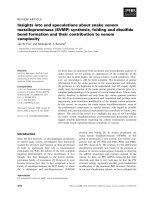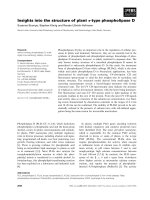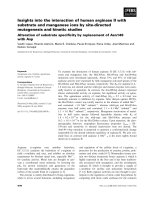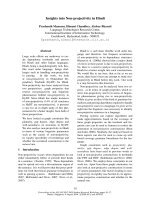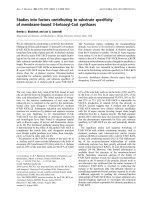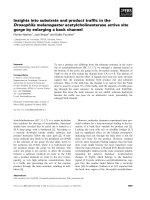Báo cáo y học: "Insights into spatial configuration of a galactosylated epitope required to trigger arthritogenic T-cell receptors specific for the sugar moiety" ppsx
Bạn đang xem bản rút gọn của tài liệu. Xem và tải ngay bản đầy đủ của tài liệu tại đây (639.55 KB, 9 trang )
Open Access
Available online />Page 1 of 9
(page number not for citation purposes)
Vol 9 No 5
Research article
Insights into spatial configuration of a galactosylated epitope
required to trigger arthritogenic T-cell receptors specific for the
sugar moiety
Simon Glatigny
1,2
, Marie-Agnès Blaton
1,2
, Julien Marin
3
, Sylvie Mistou
1,2
, Jean-Paul Briand
3
,
Gilles Guichard
3
, Catherine Fournier
1,2
and Gilles Chiocchia
1,2
1
Institut Cochin, Université Paris Descartes CNRS (UMR 8104), 27 rue du Fbg Saint Jacques, Paris, F-75014, France
2
INSERM U567, Département d'Immunologie, 27 rue du Fbg Saint Jacques, Paris, F-75014, France
3
UPR 9021 CNRS – Immunologie et Chimie Thérapeutiques (ICT), Institut de Biologie Moléculaire et Cellulaire, 15 rue René Descartes, 67084
Strasbourg Cedex, France
Corresponding author: Gilles Chiocchia,
Received: 22 Jun 2007 Revisions requested: 8 Aug 2007 Revisions received: 31 Aug 2007 Accepted: 11 Sep 2007 Published: 11 Sep 2007
Arthritis Research & Therapy 2007, 9:R92 (doi:10.1186/ar2291)
This article is online at: />© 2007 Glatigny et al.; licensee BioMed Central Ltd.
This is an open access article distributed under the terms of the Creative Commons Attribution License ( />),
which permits unrestricted use, distribution, and reproduction in any medium, provided the original work is properly cited.
Abstract
The immunodominant epitope of bovine type II collagen
(CII256–270) in A
q
mice carries a hydroxylysine-264 linked
galactose (Gal-Hyl
264
), the recognition of which is central to the
development of collagen-induced arthritis. This study explores
the molecular interactions involved in the engagement of T-cell
receptors (TCRs) with such epitopes. Responses of three anti-
CII T-cell hybridomas and clone A9.2 (all sharing close TCR
sequences) to a panel of CII256–270 analogues incorporating
Gal-Hyl
264
with a modified side chain were determined.
Recognition of naturally occurring CII256–270 peptides by
either group of T cells depended strictly upon the presence of
the carbohydrate and, more precisely, its intact HO-4 group.
Modifications of primary amino group on the hydroxylysine side
chain eliminated T-cell reactivity, notwithstanding the presence
of the galactosyl moiety. Moderate stereochemical changes,
such as altered sugar orientation and methylation at the
galactose anchor position, were still permissive. Conversely,
robust transformations affecting the relative positions of the key
elements were detrimental to TCR recognition. To conclude,
these data provide strong new experimental evidence that
integrity of both galactose HO-4 and hydroxylysine side chain
primary amino groups are mandatory for activation of anti-Gal-
Hyl
264
TCRs. They also indicate that there is a certain degree of
TCR plasticity in peptide-TCR interactions.
Introduction
Rheumatoid arthritis (RA) is a prevalent autoimmune disease
that is characterized by synovial inflammation and pannus for-
mation, which lead to irreversible cartilage and bone degrada-
tion. Although many candidate autoantigens have been
suspected of initiating a deleterious immune response in RA,
none of them have been formally identified as such. There is
considerable evidence in the literature implicating post-trans-
lational modifications of proteins in the pathophysiological
processes of human autoimmune disorders via creation of new
antigenic epitopes [1,2]. More recently, work from various
groups outlined the possible contributions made by citrullina-
tion of arginine residues in a number of different proteins to the
breakdown of self-tolerance in RA and its influence of disease
severity [3,4]. Type II collagen (CII) is another probable target
autoantigen that may be involved in the pathogenesis of RA.
This is supported by detection of CII-specific antibodies in the
serum of patients and the isolation of T cells reactive to CII
from affected synovial tissues [5]. In addition, a RA-like dis-
ease can be induced in susceptible strains of rodents and non-
human primates upon immunization with CII [6,7].
Native CII is a fibrillar protein composed of three identical
α1(II) chains derived through extracellular processing of pro-
collagen. Its synthesis involves a number of post-translational
modifications, including hydroxylation of the majority of pro-
lines and lysines that are located in the Y position of the Gly-
X-Y repeating triplet. Furthermore, during biosynthesis of
APC = antigen-presenting cell; CFA = complete Freund's adjuvant; CIA = collagen-induced arthritis; CII = type II collagen; CII256–270 = immuno-
dominant epitope of bovine CII; IL = interleukin; MHC = major histocompatibility complex; RA = rheumatoid arthritis; TCR = T-cell receptor.
Arthritis Research & Therapy Vol 9 No 5 Glatigny et al.
Page 2 of 9
(page number not for citation purposes)
cartilage pro-collagen, more than two-thirds of hydroxylysine
residues undergo glycosylation, which consists of covalent
linkage of the monosaccharide galactose (Gal-Hyl) or the dis-
accharide glucosylgalactose [8]. During the past decade, a
number of studies conducted in H-2
q
mice converged to dem-
onstrate that the high carbohydrate content of CII is associ-
ated with its arthritogenicity [9,10]. Studies have also
documented the crucial role played the glycosylation carried
by the CII256–270 epitope (the immunodominant epitope of
bovine CII) in triggering the immune T-cell response after prim-
ing with heterologous native CII in complete Freund's adjuvant
(CFA) [11,12]. Interestingly, predominant immunogenicity of
this glycosylated epitope was also identified both in human-
ized transgenic mice lacking endogenous major histocompat-
ibility complex (MHC) class II molecules but expressing RA-
associated human leucocyte antigen-DR4 and in severely
affected RA patients [13].
A few years ago, while investigating pathogenic T-cell
responses in DBA/1 (H-2
q
) mice suffering from collagen-
induced arthritis (CIA), we isolated a recurrent T-helper-1
clone, named A9.2, expressing a T-cell receptor (TCR)αβ that
shares almost identical complementarity-determining region
(CDR)3αβ with those carried by three CII-specific CD4
+
hybri-
domas generated previously [14,15]. Not only were these
cells consistently identified in lymph nodes from CII-primed
mice, but also they were shown to modulate clinical symptoms
of CIA in adoptive transfer experiments [15] or using T-cell
vaccination protocols [14,16,17]. Such regulatory effects sug-
gests that these T cells play a key role as effectors in the path-
ogenic process of CIA, rendering them appropriate targets for
peptide therapy in this disease. In the present study we evalu-
ated the molecular interactions involved in the recognition of a
glycosylated epitope by TCRs of cells that drives CIA.
Materials and methods
Synthetic peptides
The sequences of bovine and mouse CII(256–270) with and
without post-translational modifications at Pro
258
and Lys
264
are the following: Gly
256
-Glu-(Pro/Hyp)-Gly-Ile-Ala-Gly-Phe-
(Lys/Gal-Hyl)-Gly-Glu-Gln-Gly-Pro-Lys
270
(bovine) and Gly
256
-
Glu-(Pro/Hyp)-Gly-Ile-Ala-Gly-Phe-(Lys/Gal-Hyl)-Gly-Asp-
Gln-Gly-Pro-Lys
270
(mouse). The panel of modifications incor-
porated at the Gal-Hyl
264
side chain in the sequence of the
bovine or mouse immunodominant CII(256–270) glycopep-
tide is shown in Figure 1. The synthesis of N-Fmoc-protected
Gal-Hyl residue and glycosylated building blocks with modifi-
cations at the Gal-Hyl side chain (specifically, GalPiv-Hyl, Gln-
Hyl, Gal-Hyl[N
3
], Gal-Hyl [OH], Gal [5S]-Hyl and Gal [5Me]-
Hyl and Gal[6]-Hnl-[5S]-NH
2
), as well as corresponding glyc-
opeptides, were previously reported in detail [18,19]. The syn-
thesis of the Gal [4R]-Hyl building block and corresponding
glycopeptide will be described elsewhere.
Figure 1
Immunodominant CII256–270 peptide analogsImmunodominant CII256–270 peptide analogs. Shown is a schematic representation of the immunodominant epitope of bovine type II collagen
(CII256–270) peptide analogues synthetized in this study [20,21].
Available online />Page 3 of 9
(page number not for citation purposes)
T cells and hybridomas
Three anti-CII CD4
+
T-cell hybridomas (A2G10, A8E2 and
A9E5) were used in the present study. They were derived by
fusion of lymph node cells from CII-primed DBA/1 (H-2
q
) mice
and the BW5147 thymoma (mutant TCRαβ
-
) [14]. The three
anti-CII CD4
+
T-cell hybridomas used were derived from differ-
ent mice and thus represent individual clones.
The anti-CII T-cell clone A9.2 was isolated from the lymph
nodes of CII-immunized DBA/1 mice [15]. All of the cells were
cultured in RPMI 1640 glutamax supplemented with antibiot-
ics, 5 × 10
-5
mol/l mercaptoethanol, 10 mmol/l HEPES, 2
mmol/l sodium pyruvate (GIBCO, Burlington, ON, Canada)
and 7% heat-inactivated foetal calf serum, referred to below as
'complete medium'.
Determination of in vitro T-cell clone and hybridoma
reactivity
T-cell responses were assessed by means of proliferation
measurement for A9.2 clone and quantification of IL-2 secre-
tion for T hybridomas. Antigen-presenting cells (APCs) used
were either DBA/1 irradiated spleen cells (5 × 10
5
cells/well)
or paraformaldehyde-fixed M12.C10 cells (10
5
cells/well), and
an I-A
q+
B lymphoma that we generated [20]. In all of the tests,
T-cell clone (3 × 10
4
cells/well) or T hybridomas (10
5
cells/
well) were co-cultured in triplicates with APCs in the presence
of increasing concentrations of glycopeptides in a total volume
of 200 μl of complete medium. The A9.2 cell cultures were
incubated at 37°C in 5% carbon dioxide for 3 days. [
3
H]thymi-
dine (0.5 μCi/well) was added during the last 16 hours of cul-
ture, and radioactivity incorporated by the cells was
determined by liquid scintillation counting. This clone pos-
sessed a T-helper-1 phenotype, based on its high secretion of
interferon-γ but not of IL-4 or IL-5 in response to stimulation
with antigen. The interferon-γ production parallels the prolifer-
ation for all modified peptides tested. Regarding the T hybrid-
oma cultures, supernatants were collected after 24 hours of
incubation and frozen at -20°C. Thawed supernatants were
tested for their ability to support CTLL-2 (Cytotoxic T cell line
IL-2 dependant) proliferation following the procedure of
[
3
H]thymidine incoporation described above. The results were
expressed as mean of triplicates after deduction of mean back-
ground obtained by co-culture of T cells and APCs without
peptide (Δ counts/min) or as stimulation index (ratio of pep-
tide-stimulated to medium-treated co-cultures).
The studies were approved by the Cochin institute committee
on animal care. The agreement reference number to conduct
experiments in living animals is 75–777, and the animal facility
agreement reference number is 3991.
Assay for evaluation of ex vivo T-cell responses
Depending on the experiment being conducted, cell suspen-
sions were prepared from one of two sources. The first is affer-
ent lymph nodes, collected 11 days after foot pad
immunization with 100 μg peptide in CFA. The second is
peripheral lymph nodes and spleen of mice immunized with
100 μg CII in CFA and challenged with the same dose of CII
in incomplete Freund's adjuvant. One week later, single cell
suspensions were prepared and enriched in CD4
+
lym-
phocytes using the SpinSep™ kit (StemCell methodologies
inc, Vancouver, Canada) following manufacturer's recommen-
dations. In both the cases, cells were stimulated for 4 days (in
the presence of APC when responder cells were CD4
+
lym-
phocytes) with increasing concentrations of peptides. Cell
proliferation was measured by [
3
H] thymidine incorporation as
described above.
Inhibition experiments
When inhibition experiments were performed, various quanti-
ties of inhibitory peptides were pre-incubated with APCs 2
hours before the stimulatory peptide was added, at the indi-
cated concentrations, together with the T-cell hybridomas.
After 24 hours, 100 μl of the supernatant was transferred to a
new plate, which was subsequently frozen to kill any trans-
ferred T-cell hybridomas. The reactivity of the T-cell hybrido-
mas was tested with a CTLL assay as described above. All
tests were conducted in triplicate.
Results
Recurrent T-cell clones in CIA recognize exclusively
post-translational modifications of CII
Three T-cell hybridomas (named A2G10, A8E2 and A9E5)
and one T-cell clone (named A9.2) specific for CII were previ-
ously generated from bovine CII primed mice. All of these cells,
which express closely related TCRs, were found to react with
the arthritogenic CB11(II) fragment purified from native CII but
not with any of the overlapping synthetic peptides (20 mer)
that mimic the CB11 sequence, even when prolines (at Y posi-
tion of Glu-X-Y triplets) were hydroxylated (not shown). It is
likely that these cells failed to respond to deglycosylated CII,
thus suggesting that they all recognize a carbohydrate carry-
ing epitope. Sequential enzymatic cleavages of natural CB11
peptide allowed us to assign the reactivity to a fragment com-
prising the immunodominant CII256–270 epitope, in which
the hydroxylation and subsequent galactosylation of Lys
264
was shown to be crucial for stimulation of some T hybridomas
[12]. The strong dose-dependent activation of A9.2 clone and
the three T hybridomas with the synthetic Gal-Hyl
264
glycopep-
tides and the lack of reactivity against the same unmodified
Lys
264
peptides, even at high concentrations, validated this
assumption (Figure 2a).
To investigate the fine specificity of the T cells and to deter-
mine whether their TCRs bind to the same or different resi-
dues, we synthesized a panel of naturally occurring peptides
and compared their ability to trigger the A9.2 clone and hybri-
domas. In addition to hydroxylation followed by glycosylation
of Lys
264
, the CII256–270 peptide may undergo hydroxylation
of Pro
258
; we therefore focused on peptides accordingly
Arthritis Research & Therapy Vol 9 No 5 Glatigny et al.
Page 4 of 9
(page number not for citation purposes)
modified at those positions. Albeit with varying magnitude, the
response patterns to synthetic peptides used were identical,
regardless of the T cells stimulated (Figure 2a). Indeed, the
presence of sugar moiety (Gal-Hyl
264
) was mandatory for T-
cell activation, whereas hydroxylation of Pro
258
did not influ-
ence the recognition by any of the four TCRs. Because the
heterologous CII256–270 sequence differs from that of
mouse by a single conservative Glu
266
→Asp substitution, we
also tested the ability of mouse Gal-Hyl
264
peptide to trigger T-
cell reactivity. Notably, all clones were stimulated by the
mouse glycopeptide, although at higher concentrations than
bovine glycopeptide (Figure 2a). Heterologous Gal-Hyl
264
peptides, irrespective of Pro
258
hydroxylation, exhibited dose-
dependent production of IL-2 by hybridomas with a threshold
as low as 1 to 3 μmol/l as reaching a plateau at from 6 to 12
μmol/l. On the other hand, in the presence of mouse Gal-
Hyl
264
the stimulating intensity varied between T-cell hybrido-
mas and doses of at least 25 μmol/l were required to induce
detectable responses (not shown).
Integrity of galactose moiety but not its stereochemical
position is an absolute requirement for T-cell activation
To unravel the molecular and structural basis for recognition of
the CII256–270 glycopeptide by the TCRs, we synthesized
chemically modified analogues and subsequently tested their
ability to trigger the different T cells. As a first step, we
explored the impact of alterations targeting the carbohydrate
molecule. Protection of all of the hydroxy groups exposed on
the galactose molecule (peptide GalPiv-Hyl
264
) resulted in
complete loss of T-cell reactivity, whichever T cells were
Figure 2
T-cell reactivities of hybridomas A2G10, A9E5 and A8E2, and clone A9.2 to several CII256–270 analoguesT-cell reactivities of hybridomas A2G10, A9E5 and A8E2, and clone A9.2 to several CII256–270 analogues. T cells were stimulated with increasing
concentrations of synthetic peptides in the presence of antigen-presenting cells, and their responses were assessed by quantification of interleukin-
2 secretion in the supernatant or measurement of proliferation for the hybridomas and the T-cell clone, respectively. Data are expressed as means of
two to five individual experiments. (a) Recognition of a panel of naturally occurring peptides synthesized with or without the potential post-transla-
tional modifications at positions 258 and/or 264. The murine peptide comprises a Glu
266
→Asp substitution. (b) Loss of hybridoma reactivity follow-
ing changes targeting the galactose molecule linked to Hyl
264
. (c) Comparison of T-cell hybridoma and clone reactivities to cognate glycopeptide
and derivatives modified at sugar anchor position. CII256–270, immunodominant epitope of bovine type II collagen.
Available online />Page 5 of 9
(page number not for citation purposes)
tested (Figure 2b). More precisely, replacement of galactose
carried by Gal-Hyl
264
peptide with glucose (peptide Glc-
Hyl
264
; specifically, substituting the axial HO-4 of galactose by
an equatorial hydroxy group; Figure 1) totally elimiated the
responses of A2G10 and A9E5 hybridomas but retained stim-
ulation of A8E2 hybridoma. These findings point to the galac-
tose HO-4 group as a key contact with the TCRs.
Further definition of the interactioins between galactose and
TCRs was investigated by means of Gal-Hyl
264
derivatives
modified at sugar anchor position (C-5) on hydroxylysine.
Thus, two peptides were prepared: one with altered sugar ori-
entation (peptide Gal [5S]-Hyl
264
) and the other with an addi-
tional methylated substitution at C5 (peptide Gal [5Me]-
Hyl
264
). Compared with positive control stimulation obtained
with the cognate peptide Gal-Hyl
264
, inversion of the configu-
ration in peptide Gal [5S]-Hyl
264
markedly inhibited IL-2 pro-
duction by A2G10 and A9E5 hybridomas. Indeed, much
higher concentrations of the analogue were required for cell
stimulation, and even at 100 μmol/l the magnitude of the
response was half that elicited by Gal-Hyl
264
(Figure 2c). In
contrast, the change in sugar orientation obtained in peptide
Gal [5S]-Hyl
264
had little impact on recognition by A8E2 hybri-
doma and A9.2 clone. Regarding the steric hindrance created
in the vicinity of the galactosyl moiety (peptide Gal [5Me]-
Hyl
264
), this only moderately influenced activation of all the T
cells tested (Figure 2c).
The ε-primary amino group of Hyl
264
is a critical TCR-
peptide contact in Gal-Hyl
264
specific recognition
The next question we addressed concerned the role played by
the hydroxylysine side chain of Gal-Hyl
264
epitope in peptide-
TCR interaction. For this purpose, T cells were checked for
their reactivity to synthetic peptides in which the ε-primary
amino group of Hyl
264
was replaced by either an azido group
(peptide Gal-Hyl [N
3
]
264
) or a hydroxy function (peptide Gal-
Hyl [OH]
264
). In both cases, all of the T-cell responses were
eliminated (Figure 3a). Similarly, the galactosylated non-natu-
ral amino acid hydroxynorvalin (Gal-Hnv) peptide, which lacks
aminomethylene group of hydroxylysine, failed to stimulate
A8E2 hybridoma and A9.2 clone (not shown).
The relative position of the elements within Gal-Hyl
264
interacting with the TCRs is essential for T-cell activation
Having established that both galactose HO-4 and hydroxyly-
sine side chain primary amino groups were key elements in the
interaction of Gal-Hyl
264
peptide with the TCRs, we next
Figure 3
Responses of anti-CII T hybridomas upon stimulation with chemically modified CII256–270 glycopeptidesResponses of anti-CII T hybridomas upon stimulation with chemically modified CII256–270 glycopeptides. Data are expressed as means of two to
four individual experiments. Blocking effects of alterations (a) reaching the ε-primary amino group of Hyl
264
or (b) strongly affecting the stereochem-
ical position of sugar moiety. CII, collagen type II; CII256–270, immunodominant epitope of bovine type II collagen.
Arthritis Research & Therapy Vol 9 No 5 Glatigny et al.
Page 6 of 9
(page number not for citation purposes)
focused on the importance of their relative spatial configura-
tion for TCR triggering. Thus, two synthetic glycopeptides
were prepared; the first one comprised a permutation of the
carbohydrate and the amino groups (peptide Gal[6]-Hnl-
[5S]NH
2
) and, in the second one, the anchor of galactose mol-
ecule on hydroxylysine was located at position C4 instead of
C5 (peptide Gal [4R]-Hyl). Both peptides were then tested for
their ability to elicit IL-2 production by A2G10 and A8E2 cells.
Figure 3b shows that although the cognate glycopeptide Gal-
Hyl
264
induced strong, dose-dependent responses, neither of
the structural alterations totally abrogated the T-cell reactivity.
Inhibition studies and immunogenicity of synthetic
analogues
Binding of the immunodominant glycopeptide CII256–270 to
I-A
q
molecule was assigned to two residues, namely Ile
260
and
Phe
263
, and it was shown that glycosylation at position 264
did not change the MHC anchor positions [21]. Although none
of the synthetic peptides used in this study were substituted
at MHC binding positions, we explored whether the analogue
glycopeptides were able to elicit an MHC restricted immune T-
cell response. First, we pre-incubated synthetic analogues
with APCs 2 hours before the addition of stimulatory glyco-
peptide and responsive hybridomas. The pre-incubation of
APCs with two peptides modified at the sugar moiety (GalPiv-
Hyl and Glc-Hyl) and the peptide without post-translation
modification on the Lys
264
induced a dose-dependent inhibi-
tion of A8E2 hybridoma stimulation with the immunodominant
glycopeptide Gal-Hyl
264
. Conversely, the Gal [4R]-Hyl elicited
a moderate effect, probably because of the lesser avidity of
this peptide with the MHC molecule (Figure 4). Similar results
were observed with the two other hybridomas, A9E5 and
A2G10 (data not shown).
Second, we have explored whether the nonstimulating ana-
logues were able to elicit a I-A
q
restricted immune response by
testing lymph node T-cell proliferation against the peptides in
DBA/1 mice immunized with the respective peptides in CFA.
Compared with the cognate epitope (Gal-Hyl
264
), the two
glycopeptides modified at the ε-primary amino group of Hyl
264
(Gal-Hyl [N
3
] or Gal-Hyl [OH]) elicited substancial responses,
whereas the pivoylated and both analogues altering the rela-
tive position of the elements (Gal[6]-Hnl-[5S]NH
2
and Gal
[4R]-Hyl) were less immunogenic (Figure 5).
These findings confirm that modified glycopeptides were able
to generate a T-cell response and to bind the MHC molecule
present at the surface of APCs.
Discussion
This paper focuses on the molecular characterization and spa-
tial configuration involved in the recognition of the galactose
moiety within the CII256–270 immunodominant epitope. This
was achieved using several closely related T-cell clones and
hybridomas specific exclusively for the galactosylated form of
the peptide. We identified two contact points to be critical for
TCR triggering and identified potential constraints on the bind-
ing orientation.
In the present study, we probed the fine specificity of four CII-
specific T-cell clones that carry TCR expressing a unique rear-
ranged α chain (Vα17/Jα20) associated with β chains using
Figure 4
The inhibition of the response of the A8E2 hybridomaThe inhibition of the response of the A8E2 hybridoma. Gal-Hyl peptide
was used as the indicator peptide and various concentrations of com-
petitor peptides were added to each assay. Data are expressed as the
percentage of response in the absence of competitor and are repre-
sentative of at least two separate experiments. The same results were
obtained with A2G10 hybridoma.
Available online />Page 7 of 9
(page number not for citation purposes)
Vβ1, Vβ4, or Vβ10 gene segments but sharing almost identi-
cal βCDR3 sequences [14]. All of these T cells strictly
recognized the carbohydrate moiety linked to Hyl
264
within the
CII256–270 epitope because they were activated neither by
the unglycosylated peptide nor by the peptide carrying a fully
protected galactose molecule. Furthermore, the CII256–270
epitope most often undergoes hydroxylation of the Pro
258
res-
idue, but such modification had no influence on sugar-medi-
ated TCR triggering in any T cells tested. Interestingly, the T
cells raised in mice immunized with bovine CII cross-reacted
with mouse galactosylated peptide (which only differs by a
Glu
266
→Asp substitution). The fact that the magnitude of the
response to self peptide was lower and positive stimulation
required higher concentrations than with heterologous pep-
tide is unlikely to be due to greater steric hindrance of Asp ver-
sus Glu
266
, because the former residue has a shorter side
chain. Alternatively, the difference may rely on the poor affinity
to MHC of mouse peptide compared with heterologous pep-
tide [22]. It is noteworthy that, in various situations involving
autoimmunity, pathogenic T cells were shown to react to self
peptides with low affinity for MHC class II molecules, indicat-
ing that such cells escape tolerance induction and cause
autoimmunity [23,24]. Because homologous CII is known to
induce chronic arthritis in DBA/1 mice [25], the glycopeptide-
specific autoreactive cells may play a central role in perpetuat-
ing inflammation and joint destruction during the course of
CIA.
The occurrence of glycopeptide reactive T cells has been doc-
umented in numerous systems, including CD4
+
and CD8
+
T-
cell subsets. A previous study that analyzed the TCR reper-
toires used for recognition of CII(256–270) epitope according
to its potential post-translational modifications at position 264
[12] concluded that the Gal-Hyl
264
glycopeptide is immunodo-
minant; specifically, this glycopeptide stimulated most of the
CII-specific T cells, among which one hybridoma – generated
from immunized DBA/1 mice – had a TCR structure very sim-
ilar to that of the A9.2 clone. The present work supports this
conclusion and extends it to other TCRs. All of the hybridomas
and T cells we used in the study exhibited the same recogni-
tion profile, although the intensity of the responses differed
according to the hybridoma concerned. This observation is
possibly attributable to pinpoint differences in TCR structure.
Notably, within the CDR3β, only one D-region nucleotide var-
ies in either T-cell clone or hybridomas, resulting in expression
of four different amino acids at this position [14]. This D-region
encoded residue may thus directly come into contact with the
anchored sugar part of the peptide and affect the level of T-cell
responses, as shown in Figure 2.
Using a large panel of synthetic structural analogues of the
natural epitope recognized by the T cells, we were able to
define two critical molecular contacts of Gal-Hyl
264
interacting
with the TCR and to identify a certain TCR flexibility in this rec-
ognition process. One of the key elements in the peptide-TCR
interaction is the HO-4 group of the galactosyl moiety,
because the substitution of galactose by glucose, which only
affects the inversion of the stereochemistry of hydroxy group
at position C4, eliminated off T-cell activation. In addition, it
was reported that removal of any of the other hydroxy groups
did not alter the responses of Gal-Hyl
264
-specific hybridomas
[26]. The second molecular contact within the glycosylated
peptide that is not dispensable for TCR triggering is the side
chain primary amino group of Hyl
264
, because analogues
chemically modified at that position were barely recognized by
the T cells. It is plausible that the primary amine at ε position
participates in electrostatic interactions with negatively
charged residues of the TCR. Alternatively, the ε-amino group
can help to render the galactose spatial configuration suitable
for TCR recognition by bridging to Glu
266
side chain, confer-
ring higher stability upon the galactosyl moiety. The fact that
the peptide synthesized with altered sugar orientation (Gal
[5S]-Hyl peptide) activated T cells to a lesser degree favours
such a hypothesis.
A9E5 and A8E2 T cell hybridomas differed in the TCR
sequences by only one amino acid (Ala versus Val, respec-
tively) in the CDR3 region of the TRB chain [15], and A8E2 but
not A9E5 responded to Gal [5S]-Hyl peptide stimulation.
Interestingly, the relative position of the two key elements
within the cognate peptide for TCR stimulation is of crucial
importance. Slight changes, such as the introduction of a
methylene group attached to carbon C5, only minimally
influenced the levels of T-cell responses, pointing to a certain
degree of TCR flexibility. In contrast, the drastic stereochemi-
cal modifications caused by permutation of sugar and NH
2
at
the C5 position or by a shift of galactose anchor from C5 to
C4 were detrimental to TCR engagement. It would be of inter-
est now to test whether the modifications of the immunodom-
Figure 5
Immunogenicity of nonstimulating analoguesImmunogenicity of nonstimulating analogues. DBA/1 mice were immu-
nized with glycopeptides in complete Freund's adjuvant as indicated,
and their lymph node cells were tested 11 days later for their ability to
proliferate in vitro in response to the immunizing peptide. Data are
expressed as means of two to five mice per group. cpm, counts/min.
Arthritis Research & Therapy Vol 9 No 5 Glatigny et al.
Page 8 of 9
(page number not for citation purposes)
inant CII epitope described herein could induce particular T-
cell cytokine production patterns and whether the different
modified peptides could have a protective/aggravating effect
in vivo.
Conclusion
Collectively, our findings provide strong new experimental evi-
dence that integrity of both galactose HO-4 and hydroxylysine
side chain primary amino groups are mandatory for TCR acti-
vation. Thus, TCR interactions with peptide-MHC are topolog-
ically constrained, although some conformational flexibility can
occur at the binding interface. Identification of Ileu
260
and
Phe
263
as anchors in the P1 and P4 pockets of A
q
,
respectively, has been documented in different studies,
thereby providing experimental support for molecular model-
ling of the complex between A
q
molecule and CII256–270
peptide [21,22,26]. Because the αβ TCRs were reported to
dock onto the peptide-MHC with the Vα domain of the TCR
positioned over the amino-terminal half of the peptide and the
Vβ domain over the carboxyl-terminus, it is plausible that the
P5-Gal-Hyl
264
residue is facing the CDR3 α and β loops
located in the centre of the TCR, allowing direct pinpoint con-
tact between the HO-4 position of carbohydrate and TCR. In
accordance with this hypothesis, recent work focusing on the
crystal structure of an autoimmune TCR complexed with class
II peptide-MHC involved in murine experimental allergic
encephalomyelitis [27] revealed that there were few specific
contacts between the TCR CDR3 loops and the cognate
peptide.
Competing interests
The authors declare that they have no competing interests.
Authors' contributions
SG was responsible, along with MAB, for the execution of
most of the experiments as well as drafting the manuscript.
MAB was responsible for the execution of most of the experi-
ments. JM performed the majority of the studies regarding
peptide synthesis and purification. SM was responsible for the
execution of all proliferative experiments. JPB gave valuable
assistance during the period of experimentation and manu-
script preparation. GG gave valuable assistance during the
period of experimentation, particularly for peptide synthesis
and purification, and manuscript preparation. CF was respon-
sible for most of the data analysis; she was responsible for
study design coordination and the writing of the manuscript,
and interpretation and discussion of the data. GC was respon-
sible for most of the data analysis; he was responsible for
study design coordination and writing of the manuscript, and
also interpretation and discussion of the data.
Acknowledgements
The authors are indebted to Drs Orly Amar and Alexandra Doncarli for
help with the initiation of the study. They greatly acknowledge the expert
assistance of Franck Lager for breeding and husbandry of the mice, and
the collaboration of the staff of the Central Cytometry Laboratory in the
Cochin Institute.
This work was supported by institutional grants from Institut National de
la Santé et de la Recherche Médicale (INSERM) and Centre National de
la Recherche Scientifique (CNRS). JM thanks the CNRS and NeoMPS
for a predoctoral fellowship as well as the Fondation pour la Recherche
Médicale for its support.
References
1. Doyle HA, Mamula MJ: Post-translational protein modifications
in antigen recognition and autoimmunity. Trends Immunol
2001, 22:443-449.
2. Rudd PM, Elliott T, Cresswell P, Wilson IA, Dwek RA: Glycosyla-
tion and the immune system. Science 2001, 291:2370-2376.
3. Sebbag M, Moinard N, Auger I, Clavel C, Arnaud J, Nogueira L,
Roudier J, Serre G: Epitopes of human fibrin recognized by the
rheumatoid arthritis-specific autoantibodies to citrullinated
proteins. Eur J Immunol 2006, 36:2250-2263.
4. van Gaalen F, Ioan-Facsinay A, Huizinga TW, Toes RE: The devil
in the details: the emerging role of anticitrulline autoimmunity
in rheumatoid arthritis. J Immunol 2005, 175:5575-5580.
5. Kim WU, Cho ML, Jung YO, Min SY, Park SW, Min DJ, Yoon JH,
Kim HY: Type II collagen autoimmunity in rheumatoid arthritis.
Am J Med Sci 2004, 327:202-211.
6. Cathcart ES, Hayes KC, Gonnerman WA, Lazzari AA, Franzblau C:
Experimental arthritis in a nonhuman primate. I. Induction by
bovine type II collagen. Lab Invest 1986, 54:26-31.
7. Courtenay JS, Dallman MJ, Dayan AD, Martin A, Mosedale B:
Immunisation against heterologous type II collagen induces
arthritis in mice. Nature 1980, 283:666-668.
8. Dehm P, Prockop DJ: Biosynthesis of cartilage procollagen. Eur
J Biochem 1973, 35:159-166.
9. Michaëlsson E, Malmström V, Reis S, Engström A, Burkhardt H,
Holmdahl R: T cell recognition of carbohydrates on type II
collagen. J Exp Med 1994, 180:745-749.
10. Myers LK, Myllyharju J, Nokelainen M, Brand DD, Cremer MA, Stu-
art JM, Bodo M, Kivirikko KI, Kang AH: Relevance of posttransla-
tional modifications for the arthritogenicity of type II collagen.
J Immunol 2004, 172:2970-2975.
11. Bäcklund J, Treschow A, Bockermann R, Holm B, Holm L, Issaza-
deh-Navikas S, Kihlberg J, Holmdahl R: Glycosylation of type II
collagen is of major importance for T cell tolerance and pathol-
ogy in collagen-induced arthritis. Eur J Immunol 2002,
32:
3776-3784.
12. Corthay A, Bäcklund J, Broddefalk J, Michaëlsson E, Goldschmidt
TJ, Kihlberg J, Holmdahl R: Epitope glycosylation plays a critical
role for T cell recognition of type II collagen in collagen-
induced arthritis. Eur J Immunol 1998, 28:2580-2590.
13. Bäcklund J, Carlsen S, Höger T, Holm B, Fugger L, Kihlberg J, Bur-
khardt H, Holmdahl R: Predominant selection of T cells specific
for the glycosylated collagen type II epitope (263–270) in
humanized transgenic mice and in rheumatoid arthritis. Proc
Natl Acad Sci USA 2002, 99:9960-9965.
14. Chiocchia G, Manoury-Schwartz B, Boissier MC, Gahery H,
Marche PN, Fournier C: T cell regulation of collagen-induced
arthritis in mice. III. Is T cell vaccination a valuable therapy?
Eur J Immunol 1994, 24:2775-2783.
15. Doncarli A, Chiocchia G, Stasiuk LM, Herbage D, Boutillon MM,
Fournier C, Abehsira-Amar O: A recurrent valpha17/vbeta10
TCR-expressing T cell clone is involved in the pathogenicity of
collagen-induced arthritis in DBA/1 mice. Eur J Immunol 1999,
29:3636-3642.
16. Chiocchia G, Boissier MC, Ronziere MC, Herbage D, Fournier C:
T cell regulation of collagen-induced arthritis in mice. I. Isola-
tion of Type II collagen-reactive T cell hybridomas with specific
cytotoxic function. J Immunol 1990, 145:519-525.
17. Chiocchia G, Manoury B, Boissier MC, Fournier C: T cell-targeted
immunotherapy in murine collagen-induced arthritis. Clin Exp
Rheumatol 1993:S15-S17.
18. Marin J, Blaton MA, Briand JP, Chiocchia G, Fournier C, Guichard
G: Synthesis of glycopeptides from type II collagen-incorpo-
rating galactosylated hydroxylysine mimetics and their use in
Available online />Page 9 of 9
(page number not for citation purposes)
studying the fine specificity of arthritogenic T cells. Chembio-
chem 2005, 6:1796-1804.
19. Marin J, Didierjean C, Aubry A, Casimir JR, Briand JP, Guichard G:
Synthesis of enantiopure 4-hydroxypipecolate and 4-hydroxy-
lysine derivatives from a common 4,6-dioxopiperidinecarbox-
ylate precursor. J Org Chem 2004, 69:130-141.
20. Manoury-Schwartz B, Chiocchia G, Lotteau V, Fournier C: Selec-
tive increased presentation of type II collagen by leupeptin. Int
Immunol 1997, 9:581-589.
21. Rosloniec EF, Whittington KB, Brand DD, Myers LK, Stuart JM:
Identification of MHC class II and TCR binding residues in the
type II collagen immunodominant determinant mediating col-
lagen-induced arthritis. Cell Immunol 1996, 172:21-28.
22. Kjéllen P, Brunsberg U, Broddefalk J, Hansen B, Vestberg M, Ivar-
sson I, Engström A, Svejgaard A, Kihlberg J, Fugger L, Holmdahl
R: The structural basis of MHC control of collagen-induced
arthritis; binding of the immunodominant type II collagen 256–
270 glycopeptide to H-2Aq and H-2Ap molecules. Eur J
Immunol 1998, 28:755-767.
23. Ferlin WG, Mougneau E, Hugues S, Appel H, Jang MH, Cazareth
J, Beaudoin L, Schricke C, Lehuen A, Wucherpfennig KW, Glai-
chenhaus N: Self-peptides that bind with low affinity to the dia-
betes-associated I-A(g7) molecule readily induce T cell
tolerance in non-obese diabetic mice. Eur J Immunol 2004,
34:2656-2663.
24. He XL, Radu C, Sidney J, Sette A, Ward ES, Garcia KC: Struc-
tural snapshot of aberrant antigen presentation linked to
autoimmunity: the immunodominant epitope of MBP com-
plexed with I-Au. Immunity 2002, 17:83-94.
25. Boissier MC, Feng XZ, Carlioz A, Roudier R, Fournier C: Experi-
mental autoimmune arthritis in mice. I. Homologous type II
collagen is responsible for self-perpetuating chronic
polyarthritis. Ann Rheum Dis 1987, 46:691-700.
26. Holm B, Bäcklund J, Recio MA, Holmdahl R, Kihlberg J: Glycopep-
tide specificity of helper T cells obtained in mouse models for
rheumatoid arthritis. Chembiochem 2002, 3:1209-1222.
27. Maynard J, Petersson K, Wilson DH, Adams EJ, Blondelle SE, Bou-
langer MJ, Wilson DB, Garcia KC: Structure of an autoimmune
T cell receptor complexed with class II peptide-MHC: insights
into MHC bias and antigen specificity.
Immunity 2005,
22:81-92.
